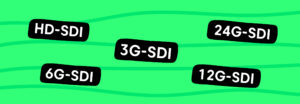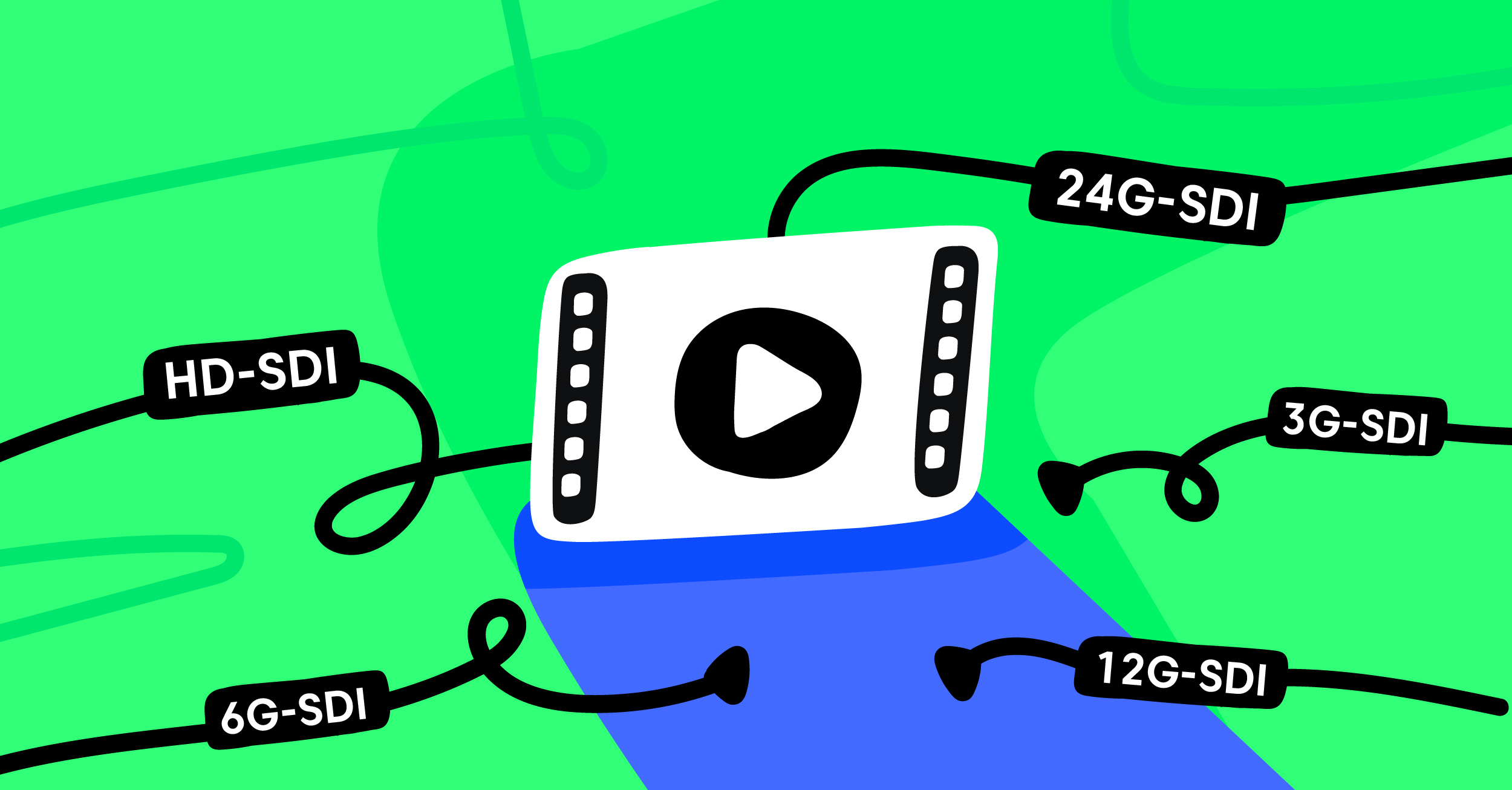Serial Digital Interface (SDI) is a video transmission standard. It works over coaxial cables. This standard is popular in professional broadcasting for its reliability and scalability nature. SDI comes in different versions. They include HD-SDI, 3G-SDI, 6G-SDI, 12G-SDI, and 24G-SDI. These versions cater to increasing demands for better video resolution and frame rates.
Each SDI version is backward compatible with earlier ones. Therefore, integrating new equipment into existing SDI structures is easy. However, video transmission quality is dictated by the lowest SDI version in the signal chain. Upgrading to higher SDI versions can greatly improve video quality and performance.
SDI is a professional broadcasting industry standard. It transmits high-quality and uncompressed digital video over coaxial cables. Several versions of SDI signals are available. These include HD-SDI, 3G-SDI, 6G-SDI, 12G-SDI, and 24G-SDI. Each version supports different video resolution levels and data transfer rates. This makes them suitable for a variety of applications.
Do you want to know how HD-SDI, 3G-SDI, 6G-SDI, 12G-SDI, and 24G-SDI variants differ?
This blog post will compare these SDI types. Let’s explore this topic further.
HD-SDI, 3G-SDI, 6G-SDI, 12G-SDI & 24G-SDI: Comparison Table
| SDI Format | Standard | Introduced | Bitrate (Mbit/s) | Example Video Format |
|---|---|---|---|---|
| SD-SDI | SMPTE 259M | 1989 | 270, 360, 143, 177 | 480i, 576i |
| ED-SDI | SMPTE 344M | 2000 | 540 | 480p, 576p |
| HD-SDI | SMPTE 292M | 1998 | 1485, 1485/1.001 | 720p, 1080i |
| Dual Link HD-SDI | SMPTE 372M | 2002 | 2970, 2970/1.001 | 1080p60 |
| 3G-SDI | SMPTE 424M | 2006 | 2970, 2970/1.001 | 1080p60 |
| 6G-SDI | SMPTE ST 2081 | 2015 | 6000 | 1080p120, 2160p30 |
| 12G-SDI | SMPTE ST 2082 | 2015 | 12000 | 2160p60 |
| 24G-SDI | SMPTE ST 2083 | 2020 | 24000 | 2160p120, 4320p30 |
What is SDI Signal?
SDI, or Serial Digital Interface, is a type of digital signal. It is used for transmitting high-quality, uncompressed video data. The broadcasting industry widely uses SDI connections due to its reliability and scalability.

SDI support ensures the transmission of video over coaxial cables. It’s standard in professional broadcasting and comes in different versions. These are:
- HD-SDI
- 3G-SDI
- 6G-SDI
- 12G-SDI
- 24G-SDI,
These versions cater to various application needs. They support different video resolution levels and data transfer rates. Each version is backward compatible, allowing for seamless integration of new equipment into existing infrastructures. However, video quality depends on the lowest SDI version in the signal chain.
Types of SDI Signals
Let’s explore the various types of SDI signals:
What is SD-SDI?
SD-SDI is a trusted SDI variation. Its full name is Standard Definition Serial Digital Interface. Its standard is SMPTE 259M.
The system originated in 1989. This makes it one of the earliest SDI versions. But that doesn’t make it redundant.
SD-SDI supports various bitrates. These are 270, 360, 143, and 177 Mbit/s. The variety allows it to handle different video quality levels.
In terms of example video formats, SD-SDI supports 480i and 576i. These formats are standard definition. This means they are suitable for basic broadcast applications.
- Standard: SMPTE 259M
- Introduced in: 1989
- Bitrate (Mbit/s): 270, 360, 143, 177
- Example Video Format: 480i, 576i
What is ED-SDI?
ED-SDI is another SDI version. It is short for Extended Definition Serial Digital Interface. Its standard is SMPTE 344M.
ED-SDI entered the scene in 2000. It brought better quality to digital video interfaces.
This version stands out with its bitrate. It supports 540 Mbit/s. This makes the transmission of richer video signals possible.
Additionally, ED-SDI handles specific video formats. These are 480p and 576p. Both offer extended definition video. This enhances pictures sent via an SDI cable.
- Standard: SMPTE 344M
- Introduced in: 2000
- Bitrate (Mbit/s): 540
- Example Video Format: 480p, 576p
What is HD-SDI?
HD-SDI stands for High Definition Serial Digital Interface. Its standard is SMPTE 292M, which was launched in 1998.
HD Serial Digital Interface supports two bitrates. These are 1485 Mbit/s and 1485/1.001 Mbit/s. That’s significantly higher than what its predecessors offered.
Such high bitrates ensure quality transmission. They maintain fidelity while sending the video signal via a coaxial cable.
The formats it supports are 720p and 1080i. These formats are high-resolution. This adds greater definition to the video data.
HD-SDI revolutionized the industry. It brought the concept of a high-definition serial digital interface to life.
- Standard: SMPTE 292M
- Introduced in: 1998
- Bitrate (Mbit/s): 1485 and 1485/1.001
- Example Video Format: 720p, 1080i
What is Dual Link HD-SDI?
Dual Link HD-SDI is an evolution in the SDI arena. It is both unique and powerful. Its standard is SMPTE 372M.
The system’s introduction was in 2002. It brought fresh capabilities to the field. It served demands unmet by existing SDI standards.
The bitrate for this new serial digital interface is remarkable. It handles both 2970 Mbit/s and 2970/1.001 Mbit/s. This greatly elevates the SDI data rate.
Moreover, its example video format is 1080p60. It guarantees high-quality and smooth video. Especially when fed into an SDI output.
- Standard: SMPTE 372M
- Introduced in: 2002
- Bitrate (Mbit/s): 2970 and 2970/1.001
- Example Video Format: 1080p60
What is 3G-SDI?
3G-SDI is another advanced SDI variant. Also known as Third Generation Serial Digital Interface. The standard is SMPTE 424M.
First introduced in 2006, it delivers robust performance. It’s an enhancement from previous versions.
What’s notable is its bitrate. It’s capable of managing 2970 Mbit/s and 2970/1.001 Mbit/s. This implies significantly high data transfer rates.
The supported video format includes 1080p60. This format delivers high-definition video. It provides smooth viewing experiences.
In essence, 3G-SDI is a step forward in video transmission. It supports high bitrate and resolution. It offers excellent video quality over a single cable. An ideal choice for broadcasters.
- Standard: SMPTE 424M
- Introduced in: 2006
- Bitrate (Mbit/s): 2970 and 2970/1.001
- Example Video Format: 1080p60
What is 6G-SDI?
6G-SDI is an advanced type of SDI. It is referred to as the Sixth Generation Serial Digital Interface. Its designated standard is SMPTE ST 2081.
It made its debut in 2015. With it surfaced greater potential for broadcasting and digital video.
An extraordinary feature is its bitrate. It supports a bitrate of 6000 Mbit/s. This allows faster data transmission.
The 6G-SDI supports superior video formats. Specifically, 1080p120 and 2160p30. These formats offer ultra-high-definition video. They translate to enhanced viewing experiences.
- Standard: SMPTE ST 2081
- Introduced in: 2015
- Bitrate (Mbit/s): 6000
- Example Video Format: 1080p120, 2160p30
What is 12G-SDI?
12G-SDI is an innovation in SDI technology. It stands for Twelfth Generation Serial Digital Interface. The standard is SMPTE ST 2082.
This format emerged in 2015. It boasts improved performance over previous versions.
A key feature of 12G-SDI is the bitrate. The supported bitrate is a whopping 12000 Mbit/s. It is a huge leap in data transmission speed.
Among its supported video formats is 2160p60. This format supports ultra-high-definition video. It ensures clear, high-resolution visuals.
- Standard: SMPTE ST 2082
- Introduced in: 2015
- Bitrate (Mbit/s): 12000
- Example Video Format: 2160p60
What is 24G-SDI?
24G-SDI represents a quantum leap in SDI technology. Its full name is Twenty-Fourth Generation Serial Digital Interface. Its standard is SMPTE ST 2083.
Just introduced in 2020, it takes SDI to a new level. It surpasses all previous versions in performance.
A significant feature is its bitrate. It supports a staggering 24000 Mbit/s. This is by far the highest data transmission rate in SDI technology.
Further, it supports exclusive video formats such as 2160p120 and 4320p30. These make way for super high-resolution videos.
In essence, 24G-SDI exhibits an unparalleled leap in capability. It offers supreme speed and extraordinary video quality. Truly, it represents the future of video transmission technology.
- Standard: SMPTE ST 2083
- Introduced in: 2020
- Bitrate (Mbit/s): 24000
- Example Video Format: 2160p120, 4320p30
HDMI vs. SDI Video Connections: What’s the Difference?
Both HDMI and SDI function as connectors. They transmit audio and video signals. But they differ in utility and performance.
SDI is popular in professional video settings. That’s the common choice for motion picture and broadcasting use. HDMI, short for High Definition Multimedia Interface, is found more in consumer electronics.
The SDI connectors have a locking mechanism. It ensures secure connections during long runs. HDMI connectors lack this feature. So, SDI connectors, known as BNC connectors, are less prone to accidental disconnections.
SDI stands out in terms of transmission distance. It can transmit signals farther than an HDMI cable can. That matters much in professional settings.
Thus, HDMI and SDI have their own merits. Deciding between the two involves a careful evaluation of specific needs.
Further Reading:
SDI vs. HDMI: Difference between SDI and HDMI Connectors









